The road to FSMA 204 compliance in 2026 may be shorter than it looks, but an accurate and comprehensive roadmap can make navigating it much less intimidating. Our webinar — Navigating the Future of Food Safety: FSMA 204 Insights and the FDA’s Roadmap for 2024 — can help you get your bearings on the first leg of the journey.
Couldn’t make it? We have you covered. Access it on demand now on the webinar’s registration page for the full conversation (including live audience Q&A) between Julie McGill, Trustwell’s VP of Supply Chain Strategy & Insights, and Angela Fields, Senior Consumer Safety Officer from the Coordinated Outbreak Response and Evaluation (CORE) Network at the U.S. Food & Drug Administration (FDA). In the meantime, read the session’s top takeaways and lessons here:
Getting Started: The FDA Has a Wealth of Resources — Use Them!
Since the announcement of the FDA’s final rule on food traceability late last year, food industry leaders have had to consider how they’ll prepare to meet new mandates outlined within it by the January 2026 deadline and what to prioritize as they get to work.
There’s a lot of ground to cover, and Fields readily acknowledges how overwhelming it can be. “The rule itself is large. There’s a lot of content within it so it can be a bit cumbersome — especially if you haven’t really done a lot of traceability work in previous years.” She told attendees that getting the right resources into the right hands has been a priority for the FDA going into 2024, including the new tools and information she and McGill spotlighted exclusively.
“Personally, I have this bookmarked and I use these materials on a daily basis,” McGill told webinar attendees, encouraging everyone to make use of the wealth of resources available in the growing FSMA Resource Library on the FDA’s website:
- New webpage for traceability lot codes
- Traceability plan examples
- Updated FAQs
- Additional supply chain scenarios
- Applying for waivers or exemptions, if eligible
Creating Traceability Lot Codes is More Straightforward Than You Think
To show just how valuable the agency’s updated resource library can be, Fields and McGill dove right into the agency’s new Traceability Lot Codes (TLC) webpage. Traceability lot code requirements simultaneously represent one of the final rule’s most important components and the first challenge for facilities to overcome if they are not familiar with the process.
Formerly known simply as “lot codes”, Fields explained that TLCs will be one of the FDA’s most valuable tools in recall investigations in case of an outbreak of foodborne illness, saying: “We use these a lot in our investigations to follow and ensure that we're tracking the right shipments across the supply chain from firm to firm. The new terminology helps make sure that it was clear to firms what we hope to do with it.”
The new page dives deep into TLC requirements and walks visitors through multiple examples of creating and applying the codes themselves, an aspect of the requirement that firms have a lot of latitude on.
That’s by design, says Fields. “There are so many business relationships and processes that have been established. We didn’t want to disrupt that. So the rule itself provides a lot of flexibility in how people can comply with it... you can create it however you like.” The TLC webpage has examples of a few ways the agency has seen firms create theirs, which can help anyone who isn’t sure where to begin, but they’re a reference point, not a referendum.
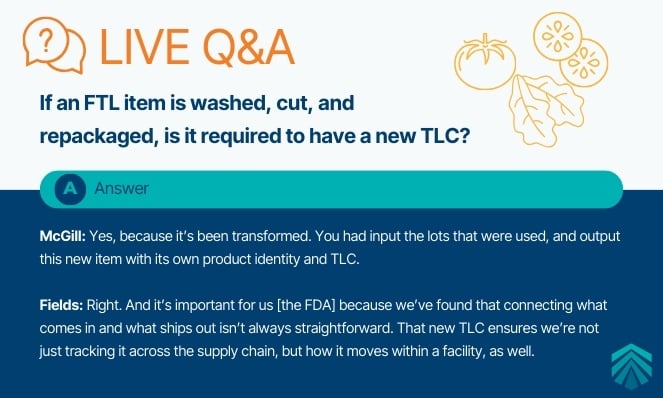
To Tackle Traceability Plans, Follow the FDA’s Lead
The flexibility built into TLC creation protects supplier and manufacturer confidentiality and keeps existing processes intact, but to be usable, the agency needs to be able to understand what they mean. Traceability Plans act as a kind of Rosetta Stone between agency and industry stakeholders.
[Read More]: FSMA 204 Tools for Success: Building a Traceability Plan
“What we’ve learned from past traceback investigations is that when we receive records from firms–because everybody's doing it a little bit differently–our ability to act quickly is hindered when we have to go back and forth to understand these very specific processes. The traceability plan was born out of that. It's an opportunity for us to get insight into how you're doing traceability within your firm… and how to analyze the records that you provided us.”
To demystify the process, the agency added examples of traceability plans — one for farms and another for restaurants — to the collection of FSMA 204 resources they offer. McGill and Fields acknowledged there would be some extra lift for teams that may not have been collecting or storing this information, but not an insurmountable one.
Compliance with FSMA 204 is An Ongoing Conversation
One of the biggest questions that lingers with FSMA 204 is, "What happens if we aren't compliant by Jan. 2026," and Fields was quick to point out that the FDA is all about education as the first step.
“We really want to educate before and while we regulate,” Fields assured the group. “These requirements are important, but if we don't have firms that can understand and apply it to their processes properly, then it's really for naught, and we won't get anything out of it. We will need to identify where some of the pain points are, or where some of the missteps are happening.”
Fields wanted to be clear that even without the authority to issue fines, the agency does have the ability to take action in instances where firms are non-compliant. "As with every other regulation, we have to enforce it if folks are not following the rules,” she said, outlining the potential consequences of waiting too long, such as:
- Voluntary actions
- Warning letters
- Civil actions
- Criminal actions
- Import refusals
Familiarizing yourself with the final rule can help avoid assumptions that result in being out of compliance, and that’s why a high-level resource like the FAQ — something Field says is updated as more questions roll in and the agency understands where further clarity is needed — can be extremely valuable.
FSMA 204 Applies to Foods, Not Countries
One such assumption is that the obligation to comply is determined by where an entity operates. It’s not. The FTL does, though, so no matter where an article originates, if it’s on the list and ends up in the U.S., it’s covered by the rule.
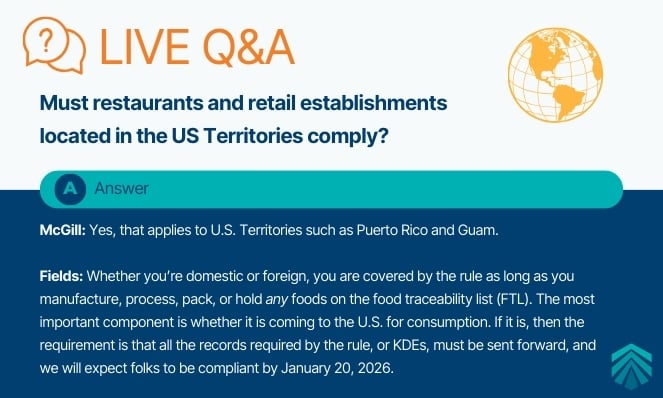
“A lot of great soft cheeses come from places outside of the United States,” McGill confirmed, underscoring the distinction. “We get a lot of our seafood from outside of the States, too — food that could be subject to refusal of admission [if they fail inspection at port] so it’s important to make sure your partners understand what they need to meet the requirements — and this is true whether it's a foreign or domestic item.”
You Don’t Have to Play the Supply Chain Scenario Guessing Game
Modernizing traceability in food safety is going to take a lot of things, including communication, planning, and data. Lots of it. The final rule requires firms that handle FTL items to collect Key Data Elements (KDEs) at specific points along the supply chain, known as Critical Tracking Events (CTEs), and supply this information to supply chain partners. This data-driven approach is what will enable impact, accuracy, and efficiency in supply chain traceability — a powerful engine in a very big machine. It’s also not an approach that can be universalized, which means firms will have to fit the pieces together themselves.
[Read More]: The Importance of Digital Compliance and Communication in Supply Chain Partnerships
Think of the FDA’s growing list of supply chain scenarios as reference schematics to make that a much less daunting prospect. McGill can’t recommend them strongly enough: “The great thing about them is how they lay out a few key things: a description of the scenario you’re looking at, and then it'll lay out all the different actors in the supply chain, the different CTEs, the activities that will have to be captured across the supply chain, and who is responsible in this scenario for having a traceability plan in place.”
Fields credits feedback from the industry for creating the supply chain scenario visualizations that have come to include specific foods like cheese or seafood and operating models like meal kit subscriptions. “We wanted to make sure that we were providing enough supply chain examples so that people could see how it applies across the board,” Fields said, pointing out that that includes “intricate scenarios where there's a partial supply chain or there's an exempt firm and we know that people sometimes understand it all a lot better when they can visualize how these interactions happen.”
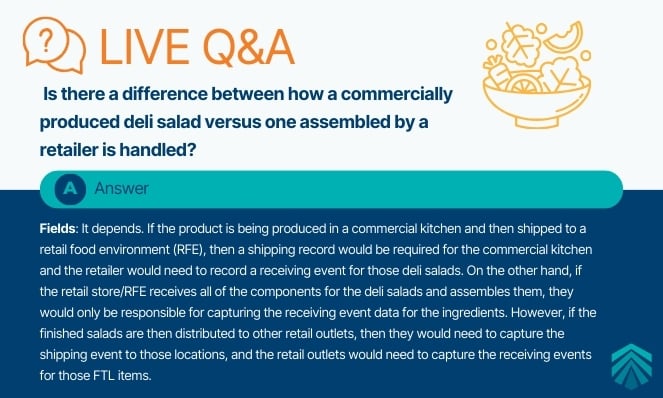
The FDA is Gearing Up for 2026 As Well
Companies within the food industry aren’t the only ones that have to work against a deadline to prepare for the FSMA 204 regulations to go into effect on January 20, 2026. While industry stakeholders take steps to capture, document, collect, and submit everything the final rule requires of them to be compliant when the time comes, the FDA will be busy getting ready to receive all of that information, Fields explained.
That means the agency is already busy laying down technological infrastructure and improving operating processes to securely receive and analyze datasets from all over the world with two big projects in 2024 and beyond — the creation of a Product Tracing System (PTS) and updates to the Safety Reporting Portal (SRP).
“We are trying to create a product tracing system that will allow us to analyze the records and analyze the digital information that we'll be receiving, and do it quickly,” Fields explained. “This will really enhance our outbreak response process, specifically traceback investigations since we hope to reduce time lost to data analyses and manipulation.”
The PCS will use the GS1 Electronic Product Code Information Services (EPCIS) open standard many companies are already using, information Fields said the agency wants to disseminate far in advance of switching it on to give organizations time to start utilizing it themselves before they’re required to submit the electronic sortable spreadsheet mandated by the final rule.
[Get the Guide]: GS1 For Supply Chain Traceability
As for the existing SRP, the FDA is making updates and additions that will allow the portal to read traceability data and act as a central location for event reporting, acknowledging that some of that information can be sensitive and emphasizing that only the FDA will be able to see information uploaded there.
“We’ve gotten some questions about whether or not the FDA will share this information with the public or through FOIA. Please know that we won't be sharing any additional information than we already have been as a result of our investigations. We understand very well that this is valuable information and it’s important we protect that,” Fields said.
To Comply on Time, Communicate Ahead of Time
Anytime an entire industry is asked to make a collective shift, that’s a big undertaking, and it simply can’t be done without a collaborative mindset and effective communication. There are a lot of stakeholders, tons of moving parts, and a finite amount of time to get everyone on the same page, from internal teams to suppliers and customers.
If you’re like the majority of our webinar attendants, you are likely in the earliest stages of what this will require, but have begun to communicate internally about how the final rule will affect you and plan your next steps. As you do, remember that it’s not only important to include the FDA itself in your FSMA 204 communication plan, as Fields insists, it’s mutually beneficial. She urged the audience to use the agency’s Technical Assistant Network (TAN) question submission form as often as needed.
“It's not falling on deaf ears, it's really important for us to have that interface and that dialogue so that we can help not only ourselves but you guys as well.” Fields insisted, explaining that the material the agency develops depends on questions and feedback submitted through TAN. “We will respond directly to those if that information is included in the submission. If we get some questions often enough, we update the FAQ. We take meeting and speaker requests whenever we can, in-person or virtually so we can understand where those pain points are and clarify existing information when we need to.”
You Have to Start Somewhere — Even if That Means Starting From Square One
At this stage, chances are high that you’re likely in the beginning stages of the journey to FSMA 204 compliance, just like most of our attendees. Just under half of the audience said they were “just starting out” and classified themselves as beginners.
- 42% — Beginners, the majority of attendees — were just getting started
- 37% — Intermediate - have read the rule, are working on a plan, and, collaborating with trading partners.
- 17% — Advanced, have attended education sessions, and are having conversations with internal and external partners
- 4% — Expert, were currently executing their program
The FDA is working to supply training and information that will keep you moving in the right direction: forward. “We are in the process of developing industry training… that will really break down all of the components of the rule, you need to do, and help you understand it.”
The agency has partnered with industry personnel to develop the material, including the Food Safety Preventative Controls Alliance (FSPCA), who will deliver the training, likely in early 2025. “We understand that this is of the utmost importance,” Fields said. “Timing is crucial and critical because twenty twenty-six will be here in the blink of an eye.”
It’s possible to get a jump start this year, said McGill, thanks to a number of upcoming events and webinars with the FDA (including Angela Fields) and industry experts (including Trustwell):
- GS1 Connect: Thrive - Expect FSMA 204 to be all over the agenda at GS1’s annual conference in Orlando this June 4-6, where McGill and Fields will sit on the same panel.
- Food Safety Consortium - in October, head to Washington, D.C. to leverage the expertise of global food industry professionals and catch McGil’s session, which will feature a discussion with representatives from the FDA, IFT, and Chipotle.
- Trustwell Events - More opportunities to learn about FSMA 204, traceability, and more with Trustwell are coming soon! Be the first to know about upcoming events — including this year’s virtual reConnect and webinars like this one — when you subscribe to our notifications and follow us on LinkedIn. In the meantime, be sure to explore our existing webinar library for more FSMA 204 content.
At Trustwell, we strive to be ‘always ahead’, and that means anticipating, understanding, and creating solutions for industry and regulatory change. We can meet you wherever you are in your compliance journey, with educational resources, consulting services, and traceability tools to help you achieve compliance in time and stay ahead of what’s next.
Contact one of our traceability experts for help creating a traceability plan, reviewing the Food Traceability List to determine what products will need additional traceability records, and learn how your company can capture, record, and store records with our FSMA 204 professional services team.
Other posts you might be interested in
View All Posts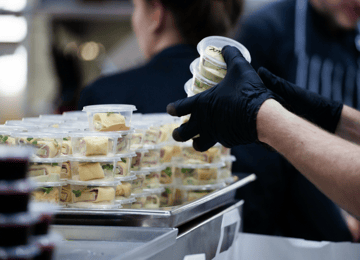
Food Industry
12 min read
| January 28, 2025
Streamline Operations with Food Specification Management: 4 Key Lessons from Trustwell’s Recent Webinar
Read More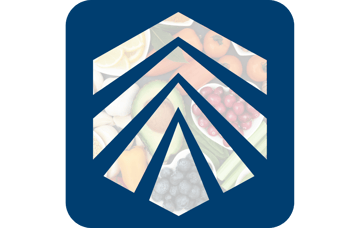
Food Industry
5 min read
| April 18, 2023
Trustwell Launches New Podcast: Transparency Talk with Trustwell
Read More
Trustwell News
4 min read
| August 29, 2023


